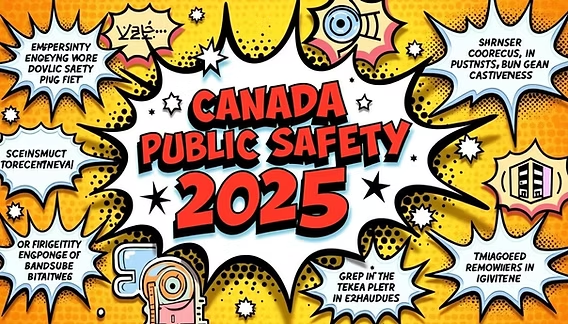In July 2025, Canada unveiled a renewed and more adaptive framework for public safety that reflects the changing dynamics of society, technology, and global risks. This new approach represents a major shift from reactive strategies to proactive, inclusive, and technology-driven systems designed to better protect communities across the country. With growing concerns about cyber threats, climate change-related disasters, and evolving social unrest, Canada’s government has acknowledged the urgent need to rethink public safety beyond traditional policing models.
Moving from Policing to Community-Based Safety
One of the most significant elements of Canada’s new public safety strategy is its clear departure from relying solely on conventional law enforcement. The government now recognizes that crime prevention, mental health support, and community engagement play just as crucial a role as law enforcement.
This strategy emphasizes a holistic approach to safety by encouraging community-led initiatives, funding neighborhood resilience programs, and prioritizing conflict de-escalation training. Investments have been made into community hubs, which serve as local centers for support services, youth engagement, addiction recovery, and outreach to marginalized groups.
The Royal Canadian Mounted Police (RCMP) and local police forces are undergoing cultural shifts, with more emphasis placed on transparency, collaboration with social workers, and the demilitarization of policing practices. This marks a strategic attempt to rebuild public trust while ensuring law enforcement remains part of a broader network of community resilience.
Incorporating Indigenous Knowledge and Leadership
Canada’s updated public safety plan takes into account the historical and systemic injustices faced by Indigenous communities. For the first time, Indigenous leaders have been invited to co-develop safety protocols specific to their regions. This includes recognizing Indigenous justice systems, land stewardship, and culturally rooted conflict resolution methods.
Public safety funding has been extended to Indigenous-led crisis response teams and programs aimed at addressing domestic violence, substance abuse, and youth mental health. These teams are supported to work independently or in cooperation with provincial authorities, depending on the needs and consent of the communities involved.
The inclusion of Indigenous practices marks a historic turning point in national safety planning and reflects Canada’s broader Truth and Reconciliation efforts.
Adopting Technology to Anticipate and Prevent Threats
In line with global trends, Canada’s public safety strategy now heavily incorporates artificial intelligence, machine learning, and predictive analytics to monitor and manage threats. The Canadian Centre for Cyber Security, operating under the Communications Security Establishment, has received expanded powers and funding to protect critical infrastructure from ransomware attacks, digital espionage, and misinformation campaigns.
Municipalities are adopting intelligent surveillance systems—not just for monitoring, but for predictive urban planning that identifies areas prone to crime, traffic incidents, and natural disasters. Data from public transportation systems, emergency calls, and health services are now integrated into smart dashboards that guide decision-making by emergency managers.
The strategy also involves privacy safeguards. In response to concerns from civil liberties advocates, Canada has reinforced legislation to ensure that AI surveillance tools operate within a framework of consent, accountability, and transparency.
Climate Resilience as a Public Safety Priority
Climate change is now central to Canada’s public safety doctrine. With wildfires, floods, and extreme heat events becoming more frequent and intense, Canada has realigned emergency response protocols to address environmental crises as security threats. The federal government has created a National Climate Emergency Response Task Force to coordinate responses across provinces.
New funding is directed toward resilient infrastructure, such as flood-resistant buildings, wildfire breaks, and heat shelters in vulnerable urban zones. In Northern Canada, where permafrost melt is threatening Indigenous settlements, emergency response teams have been deployed alongside engineers and environmental scientists to reinforce community foundations.
In addition, public education campaigns are being rolled out to train citizens in emergency preparedness, from using fire extinguishers and securing drinking water supplies to understanding evacuation procedures. Schools, workplaces, and public transport facilities now carry more visible safety instructions tailored for climate emergencies.
Public Health and Safety Interconnected
Canada’s post-COVID-19 understanding of public safety has expanded to include public health as an integral component. Public safety now considers healthcare infrastructure, communicable disease tracking, and mental wellness within the safety net. A key lesson from the pandemic was the fragility of systems when health is neglected.
New investments in mental health response units are part of the updated model. These units operate independently of police departments and are dispatched for non-violent incidents such as mental health crises, substance overdose, and welfare checks. Staffed by clinical psychologists, crisis counselors, and de-escalation specialists, these units have already been credited with reducing violent outcomes and emergency room overloads in major cities.
Another innovation is the use of health data forecasting to anticipate public health risks. When coupled with geographic and demographic data, this helps officials anticipate disease outbreaks and direct resources in advance.
Cybersecurity for Everyday Canadians
Another focal point of the national public safety strategy is to protect citizens from digital harm. The rise of scams, identity theft, online hate, and misinformation has led the government to launch a comprehensive digital literacy initiative. Canadians are now being taught how to recognize online manipulation, secure personal data, and identify phishing attempts.
Public schools, libraries, and community centers have become digital safety learning spaces. The government has launched the “Safe Clicks” campaign, a public-facing effort designed to demystify cybersecurity and foster safer digital habits among all age groups.
There are also stricter regulations on tech companies, especially regarding data collection and AI-driven targeting of users. The Office of the Privacy Commissioner has been empowered to enforce penalties and demand transparency from platforms operating in the country.
Rebuilding Trust through Transparency
Trust in public institutions has been a longstanding concern, especially in multicultural urban centers. Canada’s new public safety framework prioritizes transparent communication between authorities and the public. Townhall meetings, participatory safety planning sessions, and community liaisons have become common tools in cities and small towns alike.
A national online dashboard now allows citizens to view real-time safety alerts, air quality, cyber threat levels, and even community-specific updates. This open-data approach ensures that Canadians are not just protected but are active participants in their safety.
Moreover, all government agencies involved in public safety are now required to publish annual transparency reports that include statistics on arrests, data use, surveillance activities, and complaint resolutions.
Looking Ahead: A Model for the World?
As Canada continues to evolve its public safety systems, many observers believe the country may become a model for other democratic nations. By integrating technology, community resilience, Indigenous leadership, and climate adaptation into one coherent strategy, Canada is moving beyond outdated notions of security.
The new approach recognizes that public safety is not just about preventing crime—it is about fostering trust, well-being, resilience, and equity across the fabric of society. While challenges remain in implementation and accountability, Canada’s renewed strategy presents a comprehensive and modern blueprint for safety in a complex world.




This is good